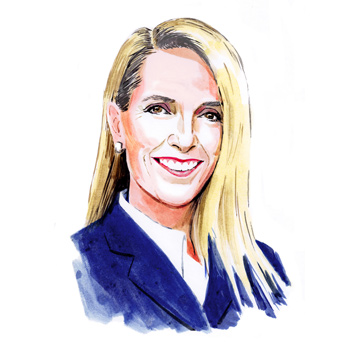
Illustrations by Amy Grimes.
Jeff Williams is thoughtful, incisive, and driven, a New Jersey native who earned a bachelor’s degree and two masters degrees in religious studies before completing his Ph.D. in the History of Christianity from Claremont Graduate University in 2005. While at Claremont, he discovered an affinity for academic administration, influenced by the then-dean of the School of Theology who suggested he apply for an open position as director of financial aid and assistant to the dean. The work, Williams says, “introduced me to a range of issues in theological education and gave me a sense that academic administration might be a calling.”
Williams continued in administrative work at Brite Divinity School as Associate Dean for 17 years, where he also became a tenured faculty member.
“The balance was never easy, but in many ways I had the best of both worlds,” he says. At both Claremont and Brite, he began to see from the inside the gradual, and troubling, signs of a sector undergoing fundamental challenges, ranging from student recruitment and new demands for modes of academic content delivery to threats to the viability of the financial model. The COVID-19 pandemic magnified the issues.
Specifically, he began to perceive “some of the challenges related to scale that so many seminaries face. I was a financial aid director, but the size of the school didn’t really require a full-time position in Financial Aid. Jack (Fitzmier, formerly the dean at Claremont) was a creative enough leader to include additional duties into my position. The hybrid nature of my position left me with an awareness of the challenges seminaries face in providing necessary services in cost-effective ways.”
Finding creative responses to serve students is what he calls his “passion project,” a journey now spanning seven years to help theological schools more effectively achieve their missions in an era of significant financial, educational, and organizational disruption. In 2022, Williams accepted a position as director of a new initiative at Annabaptist Mennonite Biblical Seminary (AMBS) in Elkhart, Ind., where he is leading the administration of a $5 million Lilly Endowment, Inc., Pathways for Tomorrow grant. The goal is to develop a multi-institutional collaboration driven by his informed insight that many of the financial challenges facing theological education today may be overcome by bundling administrative services for multiple schools.
I think there’s a strong understanding that schools might gather together in some way to share or to receive services,” Williams says, “and to benefit not only financially, which is a very important motive and need for leaders, but also to benefit in terms of the quality and range of services they can provide to their students.”

Illustrations adapted from books published by white Lion Publishing: on the Opener, Wild Places; On this page: Artistic Places
Climate Change
Along the way, Williams has found support in kindred spirits. Before Ron Ringenberg retired from his role as Vice President for Administration and Chief Financial Officer at AMBS in late 2021 (after serving in different capacities for over two decades), he also had been considering the possibilities of shared administrative services, Williams says. The two first met in late 2019, introduced by Chris Meinzer, Senior Director and Chief Operating Officer of the Association of Theological Schools (ATS). Williams had presented on the topic at the ATS Financial Officers meeting that year, and suggested that a few schools might collaborate to obtain a grant to research and design a shared services provider. Meinzer knew of Ringenberg’s interest in the topic and made the connection.
“At that point, Ron, Michele Smith (formerly the Vice President for Business and Finance at Brite Divinity School and now interim Vice President for Financial Service and CFO at Southwestern Baptist Theological Seminary) and I began exploring grant opportunities,” Williams says. “We drafted a proposal that we shared with Chris Coble (Vice President for Religion at the Lilly Endowment, Inc.) in late 2020. Chris later shared the Endowment’s plans to launch the Pathways Initiative, which seemed to Ron, Michele and me like an ideal program to support our plans.”
Williams also has an ally in David W. Boshart, Ph.D., who became AMBS’s fourth president in 2020, and who brought Williams to AMBS in 2022. A congregational pastor for more than 25 years, Boshart served as Executive Conference Minister for the Central Plains Mennonite Conference of Mennonite Church USA for nearly a decade before answering the call to lead AMBS.
Boshart is part of a wave of leadership transitions in theological education that since 2017 has shuffled the chief executive and academic officers ranks at 214 of the 280 member schools, according to data from the Association of Theological Schools (see Under Pressure).
“More than 400 seminary leaders have transitioned out in just a few years,” Boshart said on Episode 43 of the In Trust Center’s Good Governance podcast. “And it’s happened at a really fast pace, especially through the pandemic years. It’s really clear that the whole ecology of theological education is changing, and we don’t know exactly where it’s going to land.
“Stand-alone seminaries in particular are in a vulnerable place,” he says. “If ‘publish or perish’ once was the axiom in higher education, today it’s more akin to ‘collaborate or perish.’
“I think the conversation’s been going between two options,” Boshart continued. “Either you embed or merge with another institution, or you go it alone. And when you’re limited to two options, either one does not necessarily bring the robust future that you really need. The decisions (for stand-alone schools) tend to be about survival rather than mission, so we end up making very pragmatic decisions about how to keep the doors open, rather than thinking about how to free capacity and the institution to really think and focus on mission.”
Another trend impacting the sector is that nearly half of ATS schools in North America (43 percent) are now embedded in larger institutions, up from 35 percent a decade ago, according to ATS data. While the financial advantages are many, and the “halo” effect can bring greater awareness, prestige, financial resources, and attendant recruitment advantages, there also are hindrances: loss of autonomy, administrative control that is subsumed into the larger entity, board governance that is diffused and focused on the collective institution, diluted fundraising, and mission drift.
“The notion that stand-alone schools might gather together in some way to share services or to receive services is an important motive for leaders, and I don’t think we’re alone in thinking that,” Boshart says. “It’s a benefit not only financially, but also in terms of higher quality and greater range of services that they can offer their various constituents.”
The Lilly Endowment Pathways grant proposal developed by the AMBS is supporting the creation of CHANGE (Configuring Higher Education Administration for Next Generation Excellence), a project to create a non-profit entity intended to “strengthen and sustain the capacity of freestanding theological schools to prepare and support pastoral leaders for Christian churches,” according to the grant application. Annabaptist Mennonite is now collaborating with five partner institutions to determine the feasibility of creating an independent non-profit organization to operate administrative services for member schools. The goal is to scale up the depth and breadth of services available and reduce costs to the schools.
There’s a strong understanding that schools might gather together in some way to share or to receive services and to benefit not only financially, but also in terms of the quality and range of services they can provide.”
Change in the Making
As with many ambitious visions, the realization is complicated, akin to building a bridge as it’s being crossed. Williams acknowledges that in addition to operational expertise, creativity, and technological innovation, it will require time, patience and sensitivity, agility and compromise, the capacity to address fear, doubt, frustration, unforeseen roadblocks, and potential obstruction – and doing it all with the presumption of good will in the interest of achieving a broader goal.
Much of Williams’ work in the first phase since receiving the Pathways grant has been dedicated to campus discovery visits, developing a cadre of collaborating partners (other institutional representatives with an interest in shared services), research into existing shared service models in higher education, and feasibility studies.
“This is a multi-phase endeavor and we’re about halfway into the first of those phases, a research phase where we’ve invited our collaborating partners to help us learn what are the most pressing needs and desires,” Williams says.
“We’ve been listening and learning with presidents and vice presidents, board members in some cases, and also staff members. And we’re about to launch some focus groups with faculty and staff and students, who often are the beneficiaries of services.
“We particularly want to hear from them about what constitutes excellence in these services,” he continued. “And we’re also going to conduct cross-institutional focus groups to avoid specific institutional bias, something to help us understand the values held in common by the people and schools that will receive these services.”
The services that are now being considered in an initial implementation phase are those for which some level of standardization and automation might be implemented across diverse institutions, such as human resources, payroll, payments (accounts receivable and accounts payable), IT services, and Title IX.
The collaborating partners represent seminaries with head count enrollments ranging from 51 to 177 (full-time equivalent enrollment between 31 and 103 students). These smaller seminaries, Williams says, are recognizing that they often cannot provide the needed expertise to effectively deliver services, and are seeking ways to adjust their business models.
“Some of the most interesting campus conversations emerged when I asked people ‘tell me about what you do,’” Williams says. “The diversity of work is astounding. We have some incredibly talented people in theological education and the range of their responsibilities is extraordinary. You can sometimes find directors who are doing the work of administrative assistants, and I would say to them ‘What would you do if you didn’t have to do all that paperwork?’ And their eyes would just light up. They’d talk about working more directly with students, and with faculty on course design, for example, but they know they just don’t have the bandwidth.”
In their “no-stone-unturned” approach to the planning, both Williams and Boshart are sensitive to a significant concern among current staff employees who might perceive shared services as an institutional cost-savings measure that will eliminate their positions. It’s a thorny issue with significant implications and there are no clear-cut solutions.
“We don’t fire people because we can save money,” President Boshart asserts. “It’s really important to me as President of the seminary to be saying, ‘No, it’s not about cutting your job. It’s about allocating important capacities we have, and building greater capacity to focus on our mission.’”
Williams likewise acknowledges the tension in mission-driven organizations between fostering a workplace characterized by both professional and pastoral care for the individual, and the pragmatic demands of sustaining mission in a challenging business and cultural environment.
There are no easy answers, he concedes, noting that seminaries already are compelled to make frequent and difficult business decisions in order to sustain their operations and, by extension, advance their discrete missions.
Partners for Change
The CHANGE initiative began with eight partner institutions; for the first phase of data collection and analysis the partners now include:
Annabaptist Mennonite Biblical Seminary; Bethany Theological Seminary; Christian Theological Seminary; International Theological Seminary; Nazarene Theological Seminary; and New Brunswick Theological Seminary.
Structure and Governance
Those issues and others will be part of the conversations Williams will continue to have with the collaborating partners in the coming months, with ideas and proposals coming forward and being vetted by the planning and research group. He expects the process of conversations with stakeholders to be iterative over time, with ideas tested and modified through the end of 2023.
Currently, Williams and his team envision the creation of an entirely new non-profit organization to manage and lead a suite of services available to participating schools. Those services might be offered cafeteria-style, giving institutions a menu of services.
“We have been talking about a goal of reducing costs by 40 or 50 percent for some of these services,” Williams says. “We would achieve this goal by ‘scaling up’ the work of the service provider, achieving a critical mass that can create an economy of scale. You see this effect in larger universities with large student enrollments, and the efficiency they are able to generate.”
Weighing the opportunities and challenges of creating an independent entity to provide services is an evolving project, he says, particularly since in these early stages both the type and scope of services and the number of participating schools are unknown. The organization would probably be governed by a board, Williams says, but its role, size, composition, and fiduciary responsibilities are still undetermined.
“We know we can’t reasonably have 50 partners in the consortium, each with a representative on the board,” he says. “And we do not necessarily need a philanthropic board; that’s not our model.
“What we need is something a little bit more like a corporate board. We need expertise, and not all of the boards of our collaborating institutions will necessarily be able to provide members with that expertise. It’s a challenge. We do envision a board composed of at least some members from supported organizations.”
In the meantime, the collaborators (none of which have an obligation to participate beyond the research and planning phase) have a long list of pragmatic issues to consider in establishing a cross-institution organization, including how to manage confidential and proprietary institutional data, compliance issues with Title IX and other federal and state regulations, government-sponsored financial aid, and the extent to which the organization might be able and willing to provide additional resources to the participating schools – all in the context of a sector beset by rapid change.

An Abundance of Opportunities
Among the interesting challenges the CHANGE planning group has discovered so far is that some of the services with the greatest appeal may not provide significant savings, Williams says.
“Many ATS schools are in desperate need of assistance in areas where they are unable to devote sufficient human and/or financial resources. In most cases, these areas have legal and compliance implications that demand far more resources than small schools can provide. So, we are looking carefully at cost-effectiveness in these areas, as well.”
The collaborators held a meeting in June to consider benchmarks, and receive a presentation about structure and governance from an attorney with experience in board composition and best practices, Williams says. (Results were not available at the time of publication.)
For now, success centers on delivering research findings that respond to the collaborators’ concerns and needs. “In the longer term, the two most important qualitative goals are that the constituents at the schools we partner with believe that the services we ultimately offer are high quality and effective, and that the resources that the initiative frees up are devoted to enhancing the missions of our partner schools.”
Williams knows that significant work remains. “The sheer volume of opportunities, and the nuances of implementing solutions at scale across a diversity of schools with disparate needs, is a continuing challenge. I’d be less than truthful if I didn’t say there have been times when I felt intimidated by the scope of what we are trying to accomplish. We have an ambitious plan, and the Lilly Endowment has entrusted us with significant resources that I want to steward well.
“At the same time, one of the wonderful things about starting with research centered on listening is that what you learn directs the path forward. It gives me a lot more confidence and optimism that we’re on the right track.”




























